
Új könyvek
Zazzaro, Chiara
The Ancient Red Sea Port of Adulis and the Eritrean Coastal Region. Previous investigations and museum collections. (Cambridge Monographs in African Archaeology 85) Oxford: Archaeopress, 2013. BAR International Series, S2569.
Paperback | ISBN 9781407311906 | viii+107 pages; illustrated throughout in colour and black and white | £33.00
Content is available here.
Gleba, M, Pásztókay-Szeőke, J. (eds.)
Making Textiles in pre-Roman and Roman Times: People, Places, Identities. (Ancient Textiles 13) Oxford, Oxbow, 2013.
Hardback | ISBN: 9781842177679 | 240 pages b/w & col. illus. | £30.00

Contents
1. Textile Production and Trade in pre-Roman Italy Margarita Gleba
2. Textile Making – Questions Related to Age, Rank and Status Sanna Lipkin
3. Discovering the People behind the Textiles: Iron Age Textile Producers and their Products in Austria Karina Grömer
4. Textile Production and Trade in Roman Noricum Kordula Gostenčnik
5. Craftspeople, Merchants or Clients? The Evidence of Personal Names on the Commercial lead tags from Siscia Ivan Radman-Livaja
6. Female Work and Identity in Roman Textile Production and Trade: A Methodological Discussion Lena Larsson Lovén
7. Trade, Traders and guilds (?) in Textiles: the Case of Southern Gaul and Northern Italy (1st-3rd Centuries AD) Jinyu Liu
8. Textile Trade in the Periplus of the Erythraean Sea Manuel Albaladejo Vivero
9. Textiles and their Merchants in Rome’s Eastern Trade Kerstin Droß-Krüpe
10. (In)visible Spinners in the Documentary Papyri from Roman Egypt Sophie Gällnö
11. Textile Production Centres, Products and Merchants in the Roman Province of Asia Isabella Benda-Weber
12. Ulula, Quinquatrus and the Occupational Identity of Fullones in Early Imperial Italy Miko Flohr
13. A ‘Private’ Felter’s Workshop in the Casa dei Postumii in Pompeii Jens Arne Dickmann
Fulford, M., Durham, E. (eds.)
Seeing Red: New economic and social perspectives on Gallo-Roman terra sigilata. (BICS Supplement 102) London, 2013.
Hardback | ISBN 781905670475 | 446 pages | £90.00

Mass produced at a variety of locations, principally in Gaul and Germany, between the beginning of the first century and the mid third century CE, Gallo-Roman terra sigillata was consumed in very large quantities across the western provinces of the Roman Empire. The large number of records – over 425,000 – now published in Names on Terra Sigillata – the potters, their individual name dies, the associated forms, and the numbers recovered from find sites – have provided an international resource for fresh, quantitatively-based approaches to the study of terra sigillata, as presented here in Seeing Red. Twenty-six essays by leading international scholars in the field cover a range of themes including: the organization of production, distribution (inter- and intra-provincial as well as beyond the frontiers), chronology, linguistics, consumption, deposition, and iconography. The geographical scope ranges from Britain in the north-west of the Roman Empire, to the Iberian peninsula, and the western Mediterranean in the south, and from France to the lower Danube, including the Czech Republic and Poland in Central Europe.
Contents <here>
Mees, A. W.
Die Verbreitung von Terra Sigillata aus den Manufakturen von Arezzo, Pisa, Lyon und La Graufesenque. Die Transformation der italischen Sigillata-Herstellung in Gallien. (Römisch-Germanisches Zentralmuseum Monographie 93.) Regenbsburg, Schnell und Steiner Verlag, 2012.
Hardcover | ISBN 978-3-88467-173-3 | 306 Seiten mit 237 Abbildungen, 6 Tabellen, 1 CD | 60 Eur
Rezension von Manuel Flecker <hier>
Arrowsmith, Peter; Power, David
Roman Nantwich: A Salt-Making Settlement. Excavations at Kingsley Fields 2002. (BAR 557 2012) Oxford, Archaeopress, 2013.
Paperback | ISBN 9781407309590 | iii+197 pages, illustrated throughout, with CD | £35.00
In 2002 the fullest evidence so far recovered for the Roman settlement at Nantwich, a historic salt-producing centre in Cheshire (north-western England), was revealed by an excavation carried out at Kingsley Fields, on the west side of the town, ahead of a housing development. This uncovered a previously unknown Roman road, linking the settlement at Nantwich to the main road network, and, positioned along this, evidence for the collection and storage of brine and the production of salt, together with buildings, enclosures, a well and a small number of cremation burials. Waterlogged conditions meant that organic remains, including structural timbers, were well preserved on the site. These included the two finest examples of timber-built brine tanks excavated from Roman Britain. This volume presents the wide-ranging finds of these investigations. Contents: Introduction (Peter Connelly & David Power); 2) Background to the Excavation (Peter Connelly & David Power); 3) The Excavation (Peter Arrowsmith, Simon Askew, Peter Connelly & David Power); 4) Coarse Pottery (Philip Mills with Jeremy Evans); 5) Samian Ware (Felicity C Wild); 6) Coins (David Shotter); 7) Small Finds and Vessel Glass (H E M Cool); 8) Cremated Remains (Jacqueline I McKinley, Catherine Barnett & Ruth Pelling); 9) Leather (Quita Mould); 10) Wooden Objects (Peter Arrowsmith & Steven Bellshaw); 11) Quernstones (John Cruse); 12) Architectural and Altar Fragments (Peter Arrowsmith); 13) Fired Clay and Briquetage (Cynthia Poole); 14) Industrial Debris (Mark Adams); 15) Brick and Tile (Jeff Speakman); 16) Structural Timbers (Peter Arrowsmith, Michael Nevell & David Power); 17) Dendrochronological Samples of Structural Timbers (Ian Tyers); 18) Plant Macrofossils, Wood, Diatoms, Faunal Remains and Insect Analysis (Charlotte O’Brien, Lorne Elliott, Nigel Cameron, Louisa Gidney & Steve Davis), 19) Conclusion (Peter Arrowsmith & David Power); Appendix A. Kingsley Cottage, Red Lion Lane, Nantwich, A Note on the Evaluation in 2003 (Peter Arrowsmith); Appendix B. St Anne's Lane, Nantwich, A Note on the Excavations by Gifford in 2006 (Michael Nevell).
Mills, Philip
The Ancient Mediterranean Trade in Ceramic Building Materials: A Case Study in Carthage and Beirut. (Roman and Late Antique Mediterranean Pottery 2.) Oxford, Archeopress, 2013.
Paperback | ISBN 9781905739608 | 132 pages, illustrated throughout in colour and black and white, with CD | £30.00
This study (the second volume in the Archaeopress series devoted to the publication of ceramics in the Roman Mediterranean and outlying territories from the late Republic to late Antiquity) addresses the level of interregional trade of ceramic building material (CBM), traditionally seen as a high bulk low value commodity, within the ancient Mediterranean between the third century BC and the seventh century AD. It examines the impact of different modes of production, distribution and consumption of CBM and how archaeological assemblages differ from what is predicted by current models of the ancient economy. It also explores how CBM can be used to investigate cultural identity and urban form. CBM has great potential in investigating these topics. It survives in large quantities in the archaeological record; it is transported as a commodity in its own right, not as a container for other products like amphorae. The amount of CBM used in a building can be estimated, and this can be extrapolated to urban centres to model consumption in ways that are not possible for other goods. This allows the potential derivation of economic information to a higher level of precision than is the case for other materials. The material used in this study derives from stratified assemblages from two major ports of the ancient Mediterranean: Carthage and Beirut. CBM as a material is comparable to pottery, only it does not exhibit the same range of forms. This leaves fabric as a major means of analysing CBM samples. For this reason a programme of petrological thin sectioning has been carried out on these assemblages. These data have been combined with the taphonomic and dating evidence from the excavations. The results showed that the levels of imports of CBM into these two cities were much higher than would normally be expected from the orthodox model of the consumer city. They also suggest that CBM can be used as a tool to investigate cultural identity.
Contens can be read here.
Bounegru, Octavian
Mercator. Studien zur antiken Wirtschaft im Pontosgebiet und in der Ägäis. Kaiserslautern, Partneon Verlag, 2013.
ISBN: 978-3942994-06-4 | 24×17 cm | 200 S. mit 24 Abb. | 29,80 Euro

Inhaltsverzeichnis <hier>
Tellenbach, M., Schulz, R., Wieczorek, A. (eds.), Die Macht der Toga. DressCode im Römischen Weltreich. Regensburg, Verlag Schnell und Steiner, 2013.
Hardcover | ISBN 978-3-7954-2590-6 | 320 pages | € 34

Contents (chapters only)
Einführung
Rom -- das Zentrum von Macht und Einfluss; sein Hinterland; seine Vorläufer
Griechenland -- der hellenistisch geprägte, römische Osten und die Rolle der Frau
Römisches Asien -- Palmyra, Mittler zwischen Ost und West
Ägypten -- Große Vielfalt dank guter Erhaltungsbedingungen
Der Westen -- Iberien, die "römischste" aller Regionen
Der zentraleuropäische Raum -- Noricum und Pannonien (authors: U. Rothe, M. Carroll, K. Grömer, J. Pásztókay-Szeőke, T. Stolcová)
Der nordwestliche Raum -- Die Rheinprovinzen und Britannien
Außerrömische Beziehungen nach Norddeutcshland und Skandinavien
Überblick
Harding, Anthony and Kavruk, Valerii
Explorations in Salt Archaeology in the Carpathian Zone, Budapest, Archaeolingua, 2013.
Hardcover | ISBN 978-963-9911-44-4 | 332 pages
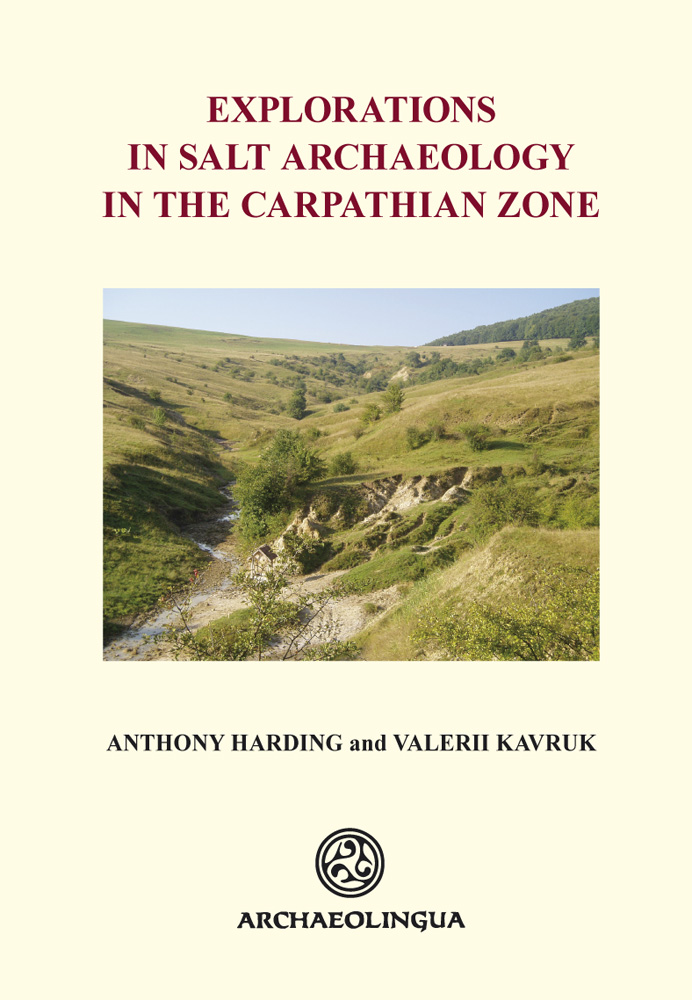
A kötet a sótermeléssel és a só használatával kapcsolatos, Közép- és Kelet-Európában folytatott régészeti kutatások eredményeit mutatja be, a 2003 és 2012 között végzett terepmunka alapján. A szerzők több ország területén vizsgáltak lelőhelyeket, de elsősorban egy észak-erdélyi területre koncentráltak, ahol számottevő mennyiségű famaradvány maradt fenn a sós vizű patakokban. A könyv a sótermelés egy eddig ismeretlen módját ismerteti, amely egy radiokarbon adatsor segítségével főként a bronzkorra keltezhető, de a későbbiekben – a vaskorban és a kora középkorban – is megtalálhatók e tevékenység nyomai. A könyv mérföldkő a só-kutatás történetében. Részletesen írja le a sókitermelés technikáját, melynek eddig a kutatók kevés figyelmet szenteltek; és elsőként szolgál bizonyítékkal a termelés pontos keltezésével kapcsolatban. Egy sor ehhez kapcsolódó témát azok szakértői mutatnak be részletesebben. A kötet röviden ismerteti a sónyerő lelőhelyeket, majd bemutatja, hagyományosan hogyan hasznosították és használják manapság is e helyeket. Ezután a feltárások ismertetése következik, kiegészítve a sólepárlás fából készült eszközeinek használatáról szóló technológiai elemzéssel, amelyet kísérleti régészeti vizsgálattal igazoltak. Ezt követően a szerzők azt elemzik, hogy a különböző termelési módok milyen módon befolyásolhatták a só terjesztését kereskedelem és csere útján.
Archibald, Zosia Halina
Ancient Economies of the Northern Aegean: Fifth to First Centuries BC, Oxford, Oxford University Press, 2013.
Hardcover |125 USD | ISBN-10: 0199682119 | ISBN-13: 978-0199682119 | 424 pages

The south-eastern tip of continental Europe was a major focus of creative energy in the second half of the first millennium BC. As the bridgehead between Europe, Asia, and the Mediterranean, the lands that corresponded to northern Greece, Bulgaria, and the European parts of Turkey became a focus of interest for a variety of external powers keen to benefit from this region's burgeoning wealth. While the ancient kingdoms of Macedon and Thrace were thought of as fringe areas of the Mediterranean, they became rich and successful, partly by exploiting the region's mineral wealth and timber and from the effective herding of livestock. In economic terms, these land-based states were strongly connected to the maritime powers of central and southern Greece and with areas far beyond the Aegean. Using the most up-to-date methods and theories about ancient economies, Archibald explores the cultural and economic dynamics of a region that continues to reveal unexpected dimensions of Classical antiquity. (Source: www.amazon.com)
Bowman, Alan and Wilson, Andrew (eds.)
The Roman Agricultural Economy. Organization, Investment, and Production, Oxford, Oxford University Press, 2013.
(Oxford Studies on the Roman Economy)
Hardcover | $150.00 | ISBN: 9780199665723
352 Pages | 103 illus. | 9.2 x 6.1 inches

Contents
1. Introduction: Quantifying Roman Agriculture, Alan Bowman and Andrew Wilson
2. The State and Production in the Roman Agrarian Economy, Dennis Kehoe
3. GIS Models of Roman Agricultural Production, Helen Goodchild
4. Agricultural Production in the Hinterland of Rome: Wine and Olive Oil, Annalisa Marzano
5. Capital Investment and Agriculture: Multi-Press Facilities from Gaul, the Iberian Peninsula and the Black Sea region, Annalisa Marzano
6. The Rural Landscape of Thugga: Farms, Presses, Mills and Transport, Mariette de Vos
7. Agricultural Productivity in Roman Egypt, Alan Bowman
8. The Agricultural Economy of the Mendesian Nome during the Roman Period, Katherine Blouin
9. Mechanical irrigation: water-lifting devices in the archaeological evidence and in the Egyptian papyri, Myrto Malouta and Andrew Wilson
10. Agriculture in the Faynan: Food Supply for Industry, Hannah Friedman
Flohr, Miko
The World of the Fullo. Work, Economy and Society in Roman Italy, Oxford, Oxford University Press, 2013.
(Oxford Studies on the Roman Economy)
Hardcover | $185.00 | ISBN: 9780199659357
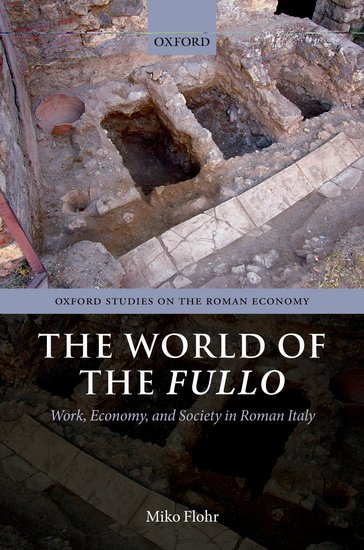
Contents
1. Introduction
2. The Economy of fulling
3. The Rational Workshop
4. Fulling and the Urban Environment
5. Populating the Fullonica
6. Fullones and Roman Society
Bowman, Alan and Wilson, Andrew (eds.)
Settlement, Urbanization, and Population,Oxford, Oxford University Press, 2012.
(Oxford Studies on the Roman Economy)
Hardcover | $135.00 | ISBN: 9780199602353
384 Pages | 78 illus. | 8.5 x 5.4 inches
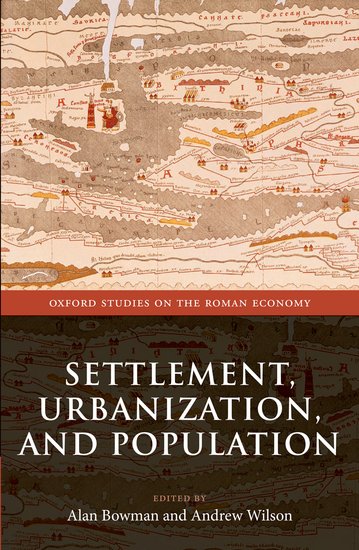
Contents
Introduction A. Bowman & A. Wilson
Survey Method and Data
1. Estimating Ancient Greek Populations: The Evidence of Field Survey, S. Price
2. Missing Persons? Models of Mediterranean Regional Survey and Ancient Populations, R. Witcher
3. Calculating Ploughzone Demographics: Some insights from arid zone surveys, D. Mattingly
4. Rural Settlement and Population Extrapolation, a Case Study from the ager of Antium, central Italy (350 BC- AD 400), P. Attema and T. de Haas
Urbanization
5. Cities, Demography, and Development in the Roman Empire, N. Morley
6. City Sizes and Urbanization in the Roman Empire, A. Wislon
7. Rank-size analysis of Roman cities in Iberia and Britain, A. Marzano
8. The Urban System of Roman Asia Minor and Wider Urban Connectivity, J. Hanson
9. Towns and Territories in Roman Baetica, S. Keay & G. Earl
10. Ptolemaic and Roman Egypt: Population and Settlement, A. Bowman
Woolf, Greg
Rome: An Empire's Story, Oxford, Oxford University Press, 2012.
Hardcover | $18 Kindle $19 | ISBN 978-0-19-077529-3
384 pages | 1.2 x 6.7 x 9.8 inches

- The Whole Story (753 B.C. - A.D. 711)
- Empires of the Mind
- Rulers of Italy (753-275 B.C.)
- Imperial Ecology
- Mediterranean Hegemony (272-133 B.C.)
- Slavery and Empire
- Crisis (146-89 B.C.)
- At Heaven's Command?
- The Generals (89-31 B.C.)
- The Enjoyment of Empire
- Emperors (31 B.C. - A.D. 235)
- Resourcing Empire
- War (15 B.C. - A.D. 284)
- Imperial Identities
- Recovery and Collapse (284-476)
- A Christian Empire
- Things Fall Apart (527-711)
- The Roman Past and the Roman Future
Review by J. Yardley in The Washington Post
Review by R. Mellor at the Times Higher Education
Review by N. S. Gill on the about.com
Review by David Gress in the Wall Street Journal
Temin, Peter
The Roman Market Economy, Princeton, Princeton University Press, 2012.
(The Princeton Economic History of the Western World)
Cloth | $35.00 / £24.95 | ISBN: 9780691147680
320 pp. | 6 x 9 | 16 line illus. 16 tables.
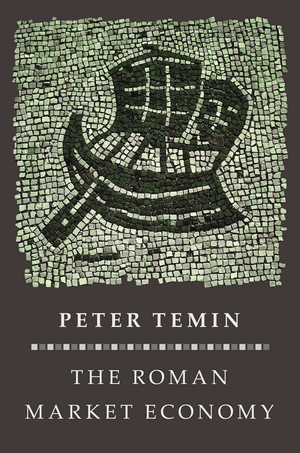
Review of the book by Plamen Ivanov
Tchernia, André
Les Romains et le commerce, Naples, Centre Jean Bérard, 2011.
Paperback | 431 pages, 10 illustrations, 1 table | ISBN 978-2-918887-06-5 | € 30

Reviewed by Andrew Wilson in the Antiquity.
Robinson, D., Wilson, A. (eds.),
Maritime Archaeology and Ancient Trade in the Mediterranean, OCMA monograph vol. 6, Oxford, Oxbow, Oxford Centre for Maritime Archaeology, 2011.
Hardcover | ISBN 9781905905171 | 250 pages, 36 col. photos, 125 col & b/w illus. | £40.00

Contents
Introduction: Maritime archaeology and the ancient economy (Andrew Wilson and Damian Robinson)
1. The Shipwrecks of Heracleion-Thonis. Preliminary study and research perspectives (David Fabre)
2. Developments in Mediterranean shipping and maritime trade from the Hellenistic period to AD 1000 (Andrew Wilson)
3. Ancient sailing routes and trade patterns: the impact of human factors (Pascal Arnaud)
4. Ceramic assemblages and ports (Candace Rice)
5. Constructing port hierarchies: harbours of the central Tyrrhenian coast (Katia Schörle)
6. Technology, innovation and trade: research on the engineering characteristics of Roman maritime concrete (John Peter Oleson, Christopher Brandon and Robert L. Hohlfelder)
7. Heracleion-Thonis and Alexandria, two ancient emporia of Egypt (Franck Goddio)
8. Lapis transmarinus: stone-carrying ships and the maritime distribution of stone in the Roman Empire (Ben Russell)
9. Dolia Shipwrecks and the Roman wine trade (Karen Heslin)
10. Location, location, location: characterizing coastal and inland production and distribution of Roman African cooking wares (Victoria Leitch)
11. A reconstruction of the maritime trade patterns originating from western Asia Minor during late Antiquity, on the basis of ceramic evidence (Theodore Papaioannou)
12. Maritime connectivity in Late Antique Lycia: a tale of two cities,Aperlae and Andriake (Robert Hohlfelder)
Aperghis, G. G.
The Seleukid Royal Economy: The Finances and Financial Administration of the Seleukid Empire, Cambridge, Cambridge University Press, 2009.
Paperback | USD 46.00 | ISBN-10: 0521117763 | ISBN-13: 978-0521117760
380 pages | 0.8 x 5.9 x 8.9 inches
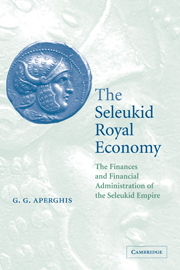
Contents
1. Sources and methods
2. Historcial summary
3. The posing of a problem
4. Geography and population
5. Production and exchange
6. The granting of land
7. Ps-Aristotle's Oikonomika Book 2.
8. Revenue
9. The handling of surpluses
10. Expenditure
11. Coinage
12. A model of the Seleukid economy
13. Financial administration
Bowman, Alan and Wilson, Andrew (eds.)
Quantifying the Roman Economy, Methods and Problems,Oxford, Oxford University Press, 2009.
(Oxford Studies on the Roman Economy)
Hardcover | $135.00 | ISBN: 9780199562596
360 Pages | 43 illus. | 8.5 x 5.4 inches

Contents
1. Introduction. Quantifying the Roman economy: integration, growth, decline?, Alan Bowman & Andrew Wilson
I. Urbanization
2. Urbanization as a proxy of demographic and economic growth, Elio Lo Cascio
3. Response to Elio Lo Cascio, Roger Bagnall
II. Field survey and demography
4. Archaeology, demography, and Roman economic growth, Willem Jongman
5. Peopling the countryside: Roman demography in the Albegna Valley and Jerba, Elizabeth Fentress
6. Peopling ancient landscapes: potential and problems, David Mattingly
III. Agriculture
7. Quantifying Egyptian agriculture, Alan Bowman
8. Response to Alan Bowman, Roger Bagnall
IV. Trade
9. Approaches to quantifying Roman trade, Andrew Wilson
10. Approaches to quantifying Roman trade: response, Michael Fulford
11. A comment on Andrew Wilson: 'Approaches to quantifying Roman trade', William Harris
V. Coinage
12. Coinage and metal supply, Bruce Hitchner
13. Roman silver coinage: mints, metallurgy, and production, Matthew Ponting
14. Some numismatic approaches to quantifying the Roman economy, Chris Howgego
VI. Prices, earnings and standards of living
15. Earnings and costs: living standards and the Roman economy, Dominic Rathbone
16. How prosperous were the Romans?, Bob Allen
17. New ways of studying incomes in the Roman economy, Walter Scheidel
Rezension von Nicolas Krocker (Frankfurter elektronische Rundschau zur Altertumskunde 19, 2012)
Elérhetőség
www.gazdtort.com
PTE BTK TTI Ókortörténeti TanszékH-7624 Pécs, Rókus u. 2.
+36-72-503600-23522